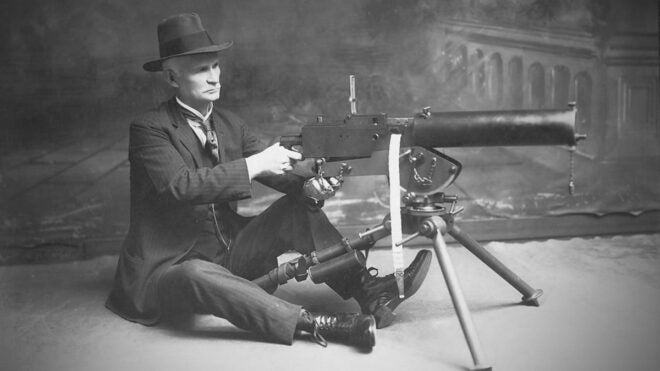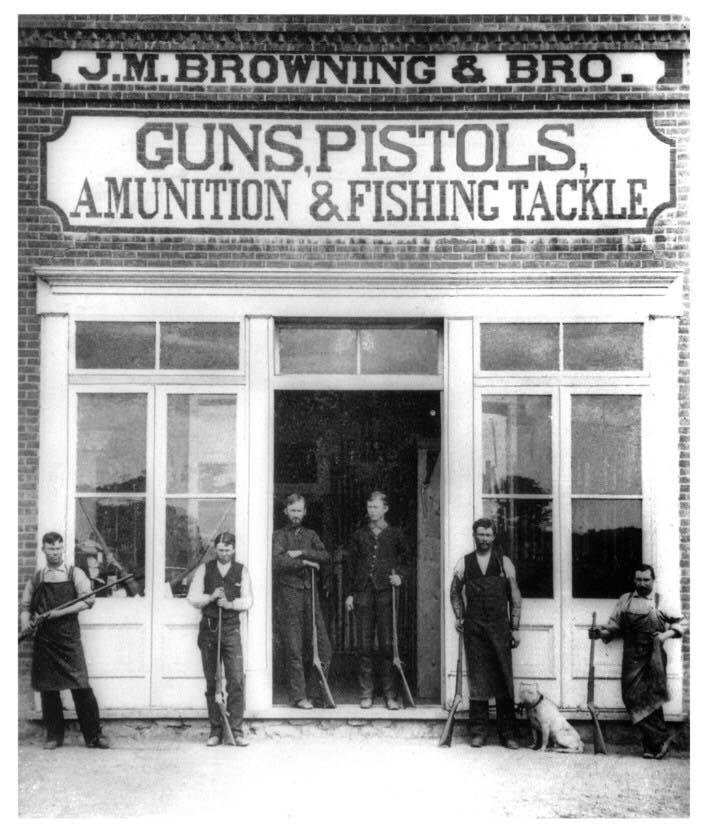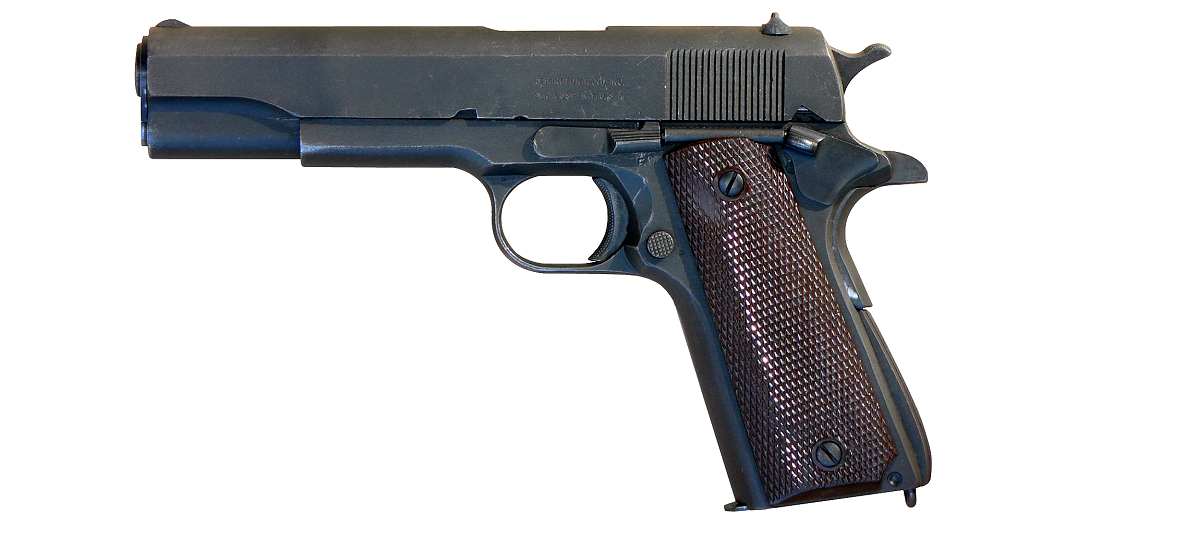John Moses Browning: A Legacy of Innovation in Firearms
Travis Olander 10.09.23

Have a penchant for long-distance shooting? What about that lever gun you love to hunt with? Or, that AR you pieced together? What about your favorite clay shootin’ shell slinger? If you love modern firearms – whether it’s a pump shotty, semi-auto pistol, or centerfire rifle – you’ve got one man to thank: John Moses Browning.
Firearm Coverage on AllOutdoor
- Home on the Range #055: Daniel Defense Soundguard SG-30Ti Silencer
- Upland Force! Federal Premium Hi-Bird 12 Gauge #5 Shot with Fiber Wad
- Curious Relics #074: A Historic Gem – The Spanish Ruby
- POTD: If The Remington and Starr Had a Baby – The Freeman revolver
John Moses Browning: Early Life
In one sentence, John Moses Browning is unarguably titled the “father of modern firearms.” To be less reductive: John Moses Browning invented, in concept and function, most of the guns we love, collect, and shoot today.
He invented the first mass-produced, reliable semi-automatic pistols (sorry, Archduke Salvator), the M1911 and the Hi-Power. He also invented the first viable pump-action shotgun, and he gave America its first military-issued light machine gun, the Browning Automatic Rifle. In so few industries does one inventor contribute so much to its modernity – yet John Browning did just that for modern guns.

Born to a Mormon family in Ogden, 1855, John Browning was one of 22 children. His father, Jonathan, a polygamist, wed three wives and established a gun shop three years prior. Browning worked under his father’s mentorship as early as age seven. The elder Browning taught his son basic engineering principles and encouraged his son to consider new firearm concepts and experiments.
John Moses Browning’s First Firearms
John Moses Browning partnered with one of his younger brothers, Matthew, to form the Browning Arms Company in 1878 and, just one year later, invented his first firearm: A single-shot falling block action rifle at the prodigious age of 13.
By 1882, some of John’s other siblings joined the company, which began mass-producing the Model 1878 Standard Single Shot Rifle, and other civilian firearms and hunting implements. In 1883, Winchester approached Browning and offered to purchase his patent for $8,000.
Thereafter, Browning worked in partnership with Winchester to produce legendary lever guns like the Winchester Models 1886, 1887, and 1894, and the M1897 “Trench Gun,” of which over one million models were produced for military, police, and civilian use.
Remington Model 8: First Successful Semi-Auto Rifle
Browning’s repeating rifles and pump guns laid the groundwork for his later – and more significant – inventions that led to the development of the guns we shoot today, starting with the Remington Model 8.
The first mass-produced semi-automatic rifle, the Model 8 was patented by Browning in 1900 and offered for sale in 1905 as the Remington Autoloading Rifle (it would be renamed the Model 8 in 1911). The Model 8 wasn’t the first rifle to introduce the concept of using recoil energy to drive the action – the first successful semi-automatic rifle was invented by an Austrian, Ferdinand Ritter von Mannlicher, in 1885.
But Browning’s knack for designing simple, reliable actions allowed over 80,000 units to be produced between 1911 and 1936. The Model 8 incorporated elements of the modern semiautomatic actions many rifles still use today: A locking, rotating bolt, actuated by a spring compressed by recoil energy, expelled spent casings. Upon rebounding, the spring drove the bolt forward, allowing it to pick up and chamber a new cartridge from the magazine.
Model 1911: First Mass-Produced Semi-Auto Pistol
It needs no introduction: The M1911 handgun, chambered in .45 ACP, is one of the most recognizable firearms ever manufactured. Browning’s design was – and still is – so reliable that the unmodified 1911 remains in service with police and military units today. Millions of examples have been produced by dozens of makers – all relying on John Moses’ original, century-old action.
The spring-actuated operation of the 1911 relies on the same basic principles Browning applied when designing his Model 8: Recoil energy is harnessed by a spring. When compressed, the spring allowed the barrel to unlock and the slide to drive rearward. As the slide actuates, the spent casing is extracted and ejected, and a new round is gathered from the magazine to be automatically chambered.
The rebounding action of the compressed spring drives the slide forward, forcing the barrel to lock as the new round is chambered. During this back-and-forth action, the hammer is cocked and the trigger resets. Like the Model 8, the 1911 wasn’t the first-ever semiautomatic handgun. But, unlike its prototype predecessors designed by other makers, Browning’s pistol provided distinct advantages that facilitated mass production and widespread adoption: Simplicity and reliability.
The M1911 was made to be disassembled with no tools. The entire assembly is held together by the static tension of the recoil spring. The first semiautomatic handgun – the Borchardt C93 – used a complicated “toggle-locking” mechanism and fired a comparatively weak cartridges. Its complex design prevented it from seeing widespread production. Meanwhile, the 1911’s simple spring mechanism and locking breech, coupled with its powerful .45-caliber cartridge, ensured the pistol could fire and cycle reliably, with good accuracy, in nearly any deteriorated condition.
M2 Browning & the .50 BMG: The First .50-Cal Firearm
These, too, need no introduction: The legendary “Ma Deuce,” or M2 Browning Machinegun, was the first ever .50-BMG chambered firearm. Following World War I, the U.S military saw the need for a powerful, maneuverable anti-aircraft weapon. U.S Army Ordnance Officers approached Browning to satisfy their need. Browning developed the 12.7x99mm round in 1921 and, to field the new cartridge, subsequently designed the M2 Machinegun at the Army’s request.
To accommodate his new round, Browning redesigned and scaled up his .30-06-chambered M1917 Machinegun, itself a renowned firearm innovation that contributed to ally victories in WWI. The M2’s trials began in October 1918; its design was finalized and official production began in 1921.
The M2 saw widespread service in WWII, the Korean War, the Vietnam War, and the Global War of Terror campaigns of the 21st century. Like the M1911, the M2 remains in service, in its unmodified, nearly totally original configuration, to this day. All branches of the U.S armed forces field some variant of the M2, and NATO militaries across the world rely on its power, maneuverability, and reliability to supplement infantry, naval, and ground mechanized units.
Sadly, the M2 would be John Moses Browning’s last invention; he died in 1926. But Browning’s contributions to the world of firearms remain as important today as they did more than a century ago — so much so, in fact, that you can now buy an M-LOK handguard for a Model 1894. What a time to be alive.




